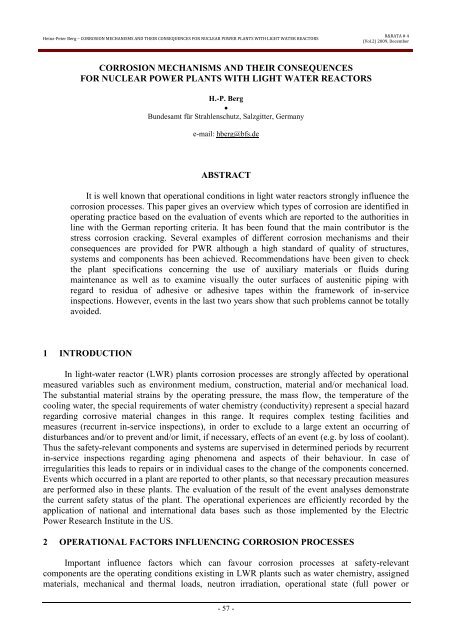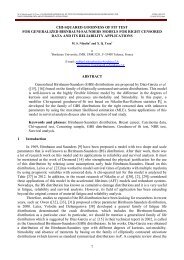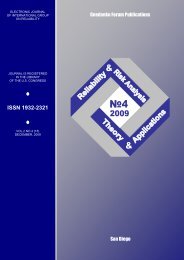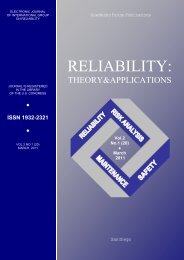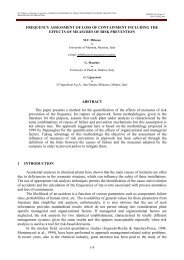CORROSION MECHANISMS AND THEIR CONSEQUENCES FOR NUCLEAR POWER ...
CORROSION MECHANISMS AND THEIR CONSEQUENCES FOR NUCLEAR POWER ...
CORROSION MECHANISMS AND THEIR CONSEQUENCES FOR NUCLEAR POWER ...
Create successful ePaper yourself
Turn your PDF publications into a flip-book with our unique Google optimized e-Paper software.
Heinz-Peter Berg – <strong>CORROSION</strong> <strong>MECHANISMS</strong> <strong>AND</strong> <strong>THEIR</strong> <strong>CONSEQUENCES</strong> <strong>FOR</strong> <strong>NUCLEAR</strong> <strong>POWER</strong> PLANTS WITH LIGHT WATER REACTORSR&RATA # 4(Vol.2) 2009, Decembercracks in geometrically more complicated places of clutters, as they frequently occur for example atwelding seam roots, are often very difficult to differentiate from background echoes.Table 1. Inspection types, procedures and techniquesType of Test Test Procedure Test TechniqueExamination withregard to cracks inthe surface or innear-surfaceregionsVolumetricexaminationMagnetic particle flaw detectionLiquid penetrant examinationUltrasonic examination procedureEddy-current examinationprocedureRadiographic examinationprocedureSelective visual examinationUltrasonic examination procedureRadiographic examinationprocedureEddy-current examinationprocedure for thin wallsIntegral visual examinationIntegral examination Pressure testFunctional testMagnetic particle examination,magnaflux examinatione.g. dye penetrant examinatione.g. surface waves, modeconversion, dual search units withlongitudinal waves, electromagneticultrasonic wavesSingle frequency, multiple frequencyX-rayRadioisotopeWith or without optical meanse.g. single probe technique withstraight (ES) or angle beamscanning, tandem (angled pitchcatch)technique, mode conversionX-rayRadioisotopeSingle frequencyMultiple frequency⎯⎯⎯The eddy current examination is an important testing method in the nuclear technology that isbased on the principle of the electromagnetic induction or eddy currents. In an electrically leadingmaterial with a field coil or a measuring probe, by which an alternating current flows, a magneticfield is produced that induces an electrical eddy current. This produces again a further magneticfield, which influenced the exciting magnetic field and thus causes a deviation of the impedance.The modification of the impedance of the receipt coil indicates cracks in the component. However,also local deviations of the electrical conductivity, the magnetic permeability and componentgeometry can lead to fault signals.In case of radiographic examination procedure the material errors can be seen as shadows on aradiographic film or a picture-giving electronic system. In the framework of the recurrent inserviceinspections, the radiographic examination procedure is not often used, which is justified bythe relatively difficult searching of cracks. Inspection of thin-walled, austenitic welding seamsshow, however, that in case of good instrumentation prerequisites and using improved inspectiontechniques the finding of cracks leads to a satisfying inspection result.5 SELECTED <strong>CORROSION</strong> FINDINGS AT PRESSURE CONDUCTINGCOMPONENTS IN PWR-SYSTEMSThe substantial material strains due to operating pressure, mass flow, and temperature of thecooling water, the special request of water chemistry (conductivity), radiation influences represent ahigher hazard regarding corrosive material modifications in the primary circle of a nuclear powerplant. This hazard requires complex testing facilities and measures in order to prevent or limit ifnecessary effects in case of occurring disturbances or of an incident (e.g. by loss of coolant). Thusthe piping systems and pressure conducting components in LWR plants are of special interest insafety engineering. Apart from operating pressure and temperature, to the characteristics of the usedmaterials as well as the sizing and constructional execution of piping systems in LWR plants, alsothe degree of purity of the cooling water plays an important role regarding corrosion processes.In Figure 3 the number of reportable events whose causes were attributed to corrosion ispresented for the period 1989 to 2001 for all nuclear power plants operated at present in Germany.- 61 -
Heinz-Peter Berg – <strong>CORROSION</strong> <strong>MECHANISMS</strong> <strong>AND</strong> <strong>THEIR</strong> <strong>CONSEQUENCES</strong> <strong>FOR</strong> <strong>NUCLEAR</strong> <strong>POWER</strong> PLANTS WITH LIGHT WATER REACTORSR&RATA # 4(Vol.2) 2009, Decemberidentified both in PWR and in BWR plants. Pitting corrosion occurs in the PWR plants with 19%whereas corrosion fatigue in the BWR systems occurs with 17% fatigue.Other corrosion types8%Strain induced cracking1%Surface corrosion13%PWRStress corrosioncracking41%Erosion corrosion10%Corrosion fatigue8%Pitting corrosion19%Other corrosion types10%BWRStrain induced cracking8%Surface corrosion4%Stress corrosioncracking39%Erosion corrosion10%Corrosion fatigue17%Pitting corrosion12%Figure 5. Distribution of corrosion types in PWR and BWR plants in Germany(Evaluation of reportable events 1968 – 2001).Corrosion influencesDesign• material• forming• surface conditionFluid• operating mode(conductibility,electrochemical potentials)• water chemistryMechanical loads• operating mode(temperature, pressure)- start-up- shutdown- operation- outageCorrosion mechanisms• contact corrosion• selective corrosion• inter-/transgranular corrosion• fretting corrosion• erosion corrosion• pitting corrosion• hydrogen embrittlement• idle corrosion• stress corrosioncracking• strain induced cracking• corrosion fatigueConsequences from operational experience(research programmes, reported events)• use of stabilized austenites• removal all of materials withchlorids• changes of construction byoptimization of the pipes• joint preparation (grinding)• austenit clads• monitoring of waterchemistry,• hydrogen operation mode• tension control• limitation of usage factors• limitation of crack growths• reduction of thermalloadsFigure 6. Root causes of different corrosion mechanisms and the operational implementation ofprotection goals in nuclear power plants.Figure 6 shows an overview of the root causes of different corrosion mechanisms, thedeveloped corrosion types and those preventive measures implemented in nuclear power plants.- 63 -
Heinz-Peter Berg – <strong>CORROSION</strong> <strong>MECHANISMS</strong> <strong>AND</strong> <strong>THEIR</strong> <strong>CONSEQUENCES</strong> <strong>FOR</strong> <strong>NUCLEAR</strong> <strong>POWER</strong> PLANTS WITH LIGHT WATER REACTORSR&RATA # 4(Vol.2) 2009, DecemberIn the following some practical examples of different corrosion types are explained, identifiedon the basis of root cause analyses by the operators of nuclear power plants with PWR.5.1 Stress corrosionDuring the spent fuel exchange, a fuel element (three service lives) was inspected which wasdetected by a Sipping test as a faulty element. The investigation showed reduced frictional forces offuel rods and a cladding damage by fretting in the area of the first measuring rod. During theendoscopy of the rod meshes one found a broken and a marked out feather/spring. The findingswere detected by visual examination and eddy current examination of fuel rods as well as frictionalforce measurement and endoscopy investigations.As a root cause, inter granular stress corrosion of the Inconel feathers/springs was determineddue to insufficient thermal treatment. The recovery of the damage took place by removing the faultyfuel rod from the fuel element. As a precautionary measure the fuel elements designated for thereapplication were enhanced by using an Inconel rod instead of zircaloy. The fuel elementsdesignated for the new application were already designed using zircaloy.5.2 Pitting and transgranular stress corrosionDuring a compression test sample of the leakage detection line of the reactor pressure vessel(RVP) flange gasket at the pipe line section, a leakage occurred within the area of the RVPisolation.A material investigation of the faulty tube part resulted in trans granular stress corrosion andpitting corrosion as a cause starting from a limited area with chloride deposits inside the tube. Thoselimited deposit and damage areas were determined by the temperature distribution (reactor pressurevessel outside temperature to ambient temperature) in the line.For the recovery of the damage, the concerned and a comparable piece of piping wasexchanged by two new tube parts with more corrosion-resistant material. A check of thecomparable piece of pipe by a surface crack check of the half shells after isolating did not result inany findings.5.3 Chloride-induced stress corrosionIn the context of the annual complete overhaul in a plant by a compression test of the leakageexhausting line, tear findings at small lines of the control valves of the pressurizer equipment stationwere determined. Due to these findings extensive additional examinations of the small lines of thepressure owner armature station took place. Tear findings resulted in the case of two further leakageexhausting lines as well as at the stuffing box return pipe of the pressurizer relief / isolating valve.All other inspections of the small lines showed no findings. The tear findings did not haveinfluence on the function behaviour of the pressure water relief valves. As a cause, a chlorideinducedtrans granular stress corrosion starting from the tubing inside was determined. The placescorroded were in the transition from the thermally isolated to the not-isolated part of the pipingwithin the areas where steam condenses.A concentration of minimal chloride quantities which can not be excluded could not beavoided in this area. The damage was recovered by the exchange of the affected piping. To clarifythe root cause further investigations of the concerned piping are performed. As a precautionarymeasure, an improved monitoring of the plugging book and leakage exhausting lines was realizedby annual compression tests and non-destructive tests every four years.Also in case of stabilized austenitic steel stress corrosion can occur under unfavourableconditions. Thus e.g. in earlier years the phenomenon of the "trans granular stress corrosion" was- 64 -
Heinz-Peter Berg – <strong>CORROSION</strong> <strong>MECHANISMS</strong> <strong>AND</strong> <strong>THEIR</strong> <strong>CONSEQUENCES</strong> <strong>FOR</strong> <strong>NUCLEAR</strong> <strong>POWER</strong> PLANTS WITH LIGHT WATER REACTORSR&RATA # 4(Vol.2) 2009, Decemberdetermined in particular within the area of austenitic piping and identified by extensiveinvestigations as "chloride-induced stress corrosion". Due to the fact that the cooling agent does notcontains chloride, no findings in respective through piping were observed. A "chloride-inducedstress corrosion" can develop only if chloride containing substances together with water (sometimesonly humidity) react due to concentration or deposits.More general one can say that chloride-induced trans granular stress corrosion cracking(TGSCC) has occurred in German plants on fasteners as well as at inner and outer surfaces ofpiping all made of stabilised stainless steel due to contact with chloride-containing lubricants,sealing and auxiliary materials or fluids. The fasteners affected were located in the connections ofcore barrel/core baffle and in the reactor pressure vessel internals.To prevent future damage, a chloride-free lubricant is to be used and changes are made in thedesign of the bolts to reduce notch stresses, TGSCC at inner surfaces has mainly been observed insmall diameter pipes due to chloride-containing seals, which were replaced with chloride-free onesto prevent future damage. However, in some small pipes in which moistening and drying alternatefor technological reasons, chloride concentrations may reach a critical level due to fortification evenwithout any outer chloride source.In the 90s some crack incidents from outer surface occurred even at piping of larger nominalbore. They have had no direct impact on plant safety. None of the events with leakage, whichoccurred at operating systems, would have led to an actuation of the safety systems, even in the caseof pipe rupture. The availability of the safety systems concerned was given because of theirredundancy. However, there was a loss of reliability in operating and safety systems.Recommendations have been given to check the plant specifications concerning the use of auxiliarymaterials or fluids during maintenance as well as to examine visually the outer surfaces of austeniticpiping with regard to residua of adhesive or adhesive tapes within the framework of in-serviceinspections (Michel et al. 2001), (Schulz 2001).In the revision of the year 2007 cracks were found in austenitic armatures of a nuclear powerplant with BWR (cf. Fig. 7). 23 of 34 analyzed armatures are showing typical intra granularcorrosion cracking.This phenomenon typically occurs in the temperature region between 60°C und 90°C understagnating medium conditions with a concentration of chlorine ions. Obviously it's most importantto avoid chloride concentrations as far as possible in the future.5.4 Flow-accelerated corrosionFlow-accelerated corrosion (FAC) is a world -wide problem in carbon or low-alloy steelpiping of water/steam circuits of power plants. The experience with FAC on carbon steel piping inplants with PWR is summarised in Figure 8 (see (Schulz 2001)). To avoid FAC, in the 80s theGerman utilities replaced their condenser tubes made of copper alloys with new ones made ofstainless steel or titanium. This replacement action creates suitable conditions for changing thewater chemistry to „High“-All Volatile Treatment (HAVT, pH level >9.8).Furthermore, the implementation of the basic safety concept led to improved flow conditions.In consequence, no damage with safety relevance has occurred in German NPPs due to FAC.Boric acid corrosion of plants with PWRs may cause boric acid corrosion damage to lowalloyor carbon steel base material. Corresponding incidents occurred e.g. in the 80s in some USplants in areas on the reactor vessel head. In Germany, it is good practice not to operate withprimary coolant leakage. In so far, boric acid corrosion is not an issue in Germany.- 65 -
Heinz-Peter Berg – <strong>CORROSION</strong> <strong>MECHANISMS</strong> <strong>AND</strong> <strong>THEIR</strong> <strong>CONSEQUENCES</strong> <strong>FOR</strong> <strong>NUCLEAR</strong> <strong>POWER</strong> PLANTS WITH LIGHT WATER REACTORSR&RATA # 4(Vol.2) 2009, DecemberFigure 7. A typical example of a chloride-induced stress corrosion.Figure 8. Thinning in PWR carbon steel piping due to flow-accelerated corrosion.5.5 Idle corrosionIn the reactor cooling system of a PWR plant findings were determined in the area of theground hand plating of the main cooling agent line. The findings were analyzed in the context of therecurrent in-service inspection (visual examination of the interior surface of the component) in thecurrent revision by means of submarine. In relation to preceding checks the interior surfaces wereinvestigated with an improved video system. First findings were identified in the area of the groundhand plating of the cold TH feeding connecting piece in one loop. After extension of theexamination to all loops several displays were determined. The displays were situated all in the areaof the ground hand plating. The integrity of the pressure boundaries was not impaired. As a rootcause production related local and slag inclusions in ground position transitions of the hand platingwere identified. The evaluation is not yet completed; however, operators and experts determinedidle corrosion as a root cause. Whereas ferritic and austenitic steel is steady to a corrosion attackduring the operation phase due to adjusted water chemistry, an idle corrosion is possible in case of alonger system status at lower temperature and sufficiently loosened oxygen in the medium. Thefollowing assumptions are currently under discussion:- 66 -
Heinz-Peter Berg – <strong>CORROSION</strong> <strong>MECHANISMS</strong> <strong>AND</strong> <strong>THEIR</strong> <strong>CONSEQUENCES</strong> <strong>FOR</strong> <strong>NUCLEAR</strong> <strong>POWER</strong> PLANTS WITH LIGHT WATER REACTORSR&RATA # 4(Vol.2) 2009, December1. During operation the corrosion potentials are alike with contacting ferritic and austeniticmaterial areas (e.g. ferritic basic material with austenitic plating). By the use of an anti -corrosiveprotective layer consisting of magnetite of both materials the same corrosion potentials areassumed. Because the temperature was below the operating temperature sturdier magnetite isconverted into the fewer sturdy trivalent ferric oxide/hydroxide. Breaking the ferric oxide/hydroxidelayer and the medium enriched with oxygen cause a corrosion attack of the unprotected ferrite.2. The active corrosion in the ferritic material affected via a locally different concentration ofoxygen in the medium with ventilated (cathode) and not ventil ated areas (anode) at the metalsurface. The difference between the oxygen concentration and an oxygen depletion within thehollow area causes a potential difference and produces a current flow, which leads to the localdissolution of metal.Results of these discussions are expected up to the end of the first quarter of 2010.6 FINAL CONSIDERATIONSThe corrosion protection in the nuclear power plant technology is primarily the result of theoperational experience over many years. During the last thirty years the high quality standard wasdeveloped by construction, manufacturing and quality assurance. It corresponds to the guidelines ofthe German Reactor Safety Commission and the relevant safety rules of the Nuclear SafetyStandards Committee for German nuclear power plants.By the application of optimized manufacturing processes and inspection techniques, materialswith high-quality properties, in particular the tenacity, conservative limitation of the voltages,minimization of voltage peaks by optimal construction (avoidance of notches, sharp edges etc.) aswell as evaluation of occurred failures the important measured influence factors of the corrosionphenomena could be reduced. The design of safety-relevant components is executed in nuclearpower material -, manufacturing and test-fairly manner, also concerning the recurrent in-serviceinspections.Thus following the state of the art for example in case of the reactor pressure vessel, weldingseam constructions are minimized and replaced by smooth forgings. The use of qualitatively perfectproduct forms as well as a qualified and controlled welding seam manufacturing, by which thegrowth of stress corrosion is reduced as a consequence of the elimination of chromium carbides atthe grain boundaries, is at present standard.Numerous research work in the field of corrosion in nuclear installations is in closeconnection with the study of the boundaries, where corrosion cracking can occur. Experiences onthe measured variables, which for example, determine the effectiveness of the environmentmedium, the height of the voltages and the corrosion resistance of the materials, allow to improvethe construction and production of component components, but also the operation of nuclear powerplants in an optimal manner.Operational modifications such as aging by increase of the corrodibility are pursued byrecurrence in the course of the decades with the help of further developed measuring technique andbetter estimation of life times. Likewise it is possible by the modern measuring technique to identifyfindings which could now be made visible but not in earlier years.There are, nevertheless, still questions which are not yet sufficiently clarified in the area of thecorrosion research. For a further extension of the present level of knowledge, investigations wouldbe desirable in particular to the following topics:− investigations of individual alloying constituents of austenitic materials and nickel basedalloys, by which the radiation-induced stress corrosion can be influenced.− investigations to radiation-influenced material modifications, radiation-induced stresscorrosion and its distinction from inter granular stress corrosion.- 67 -


